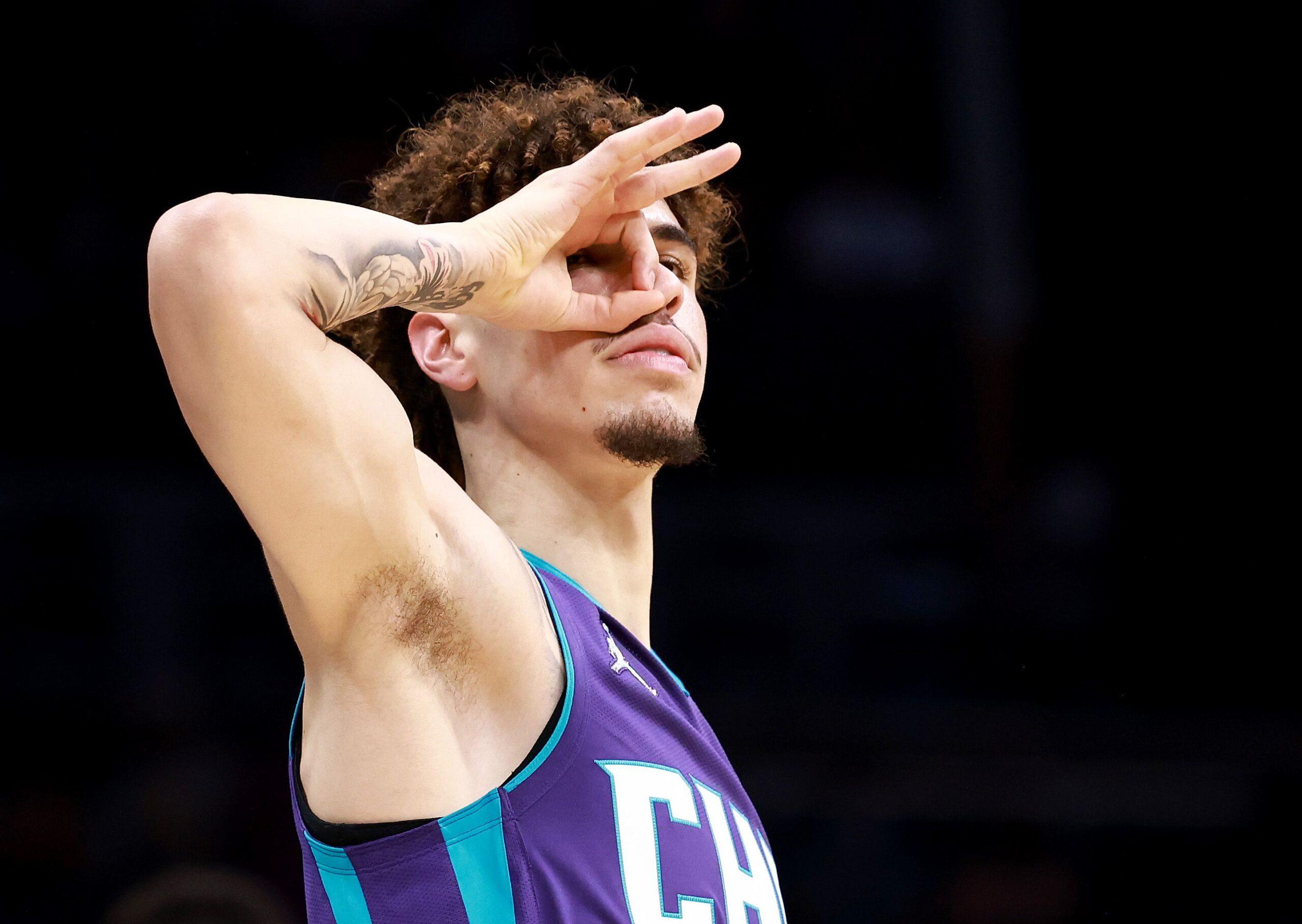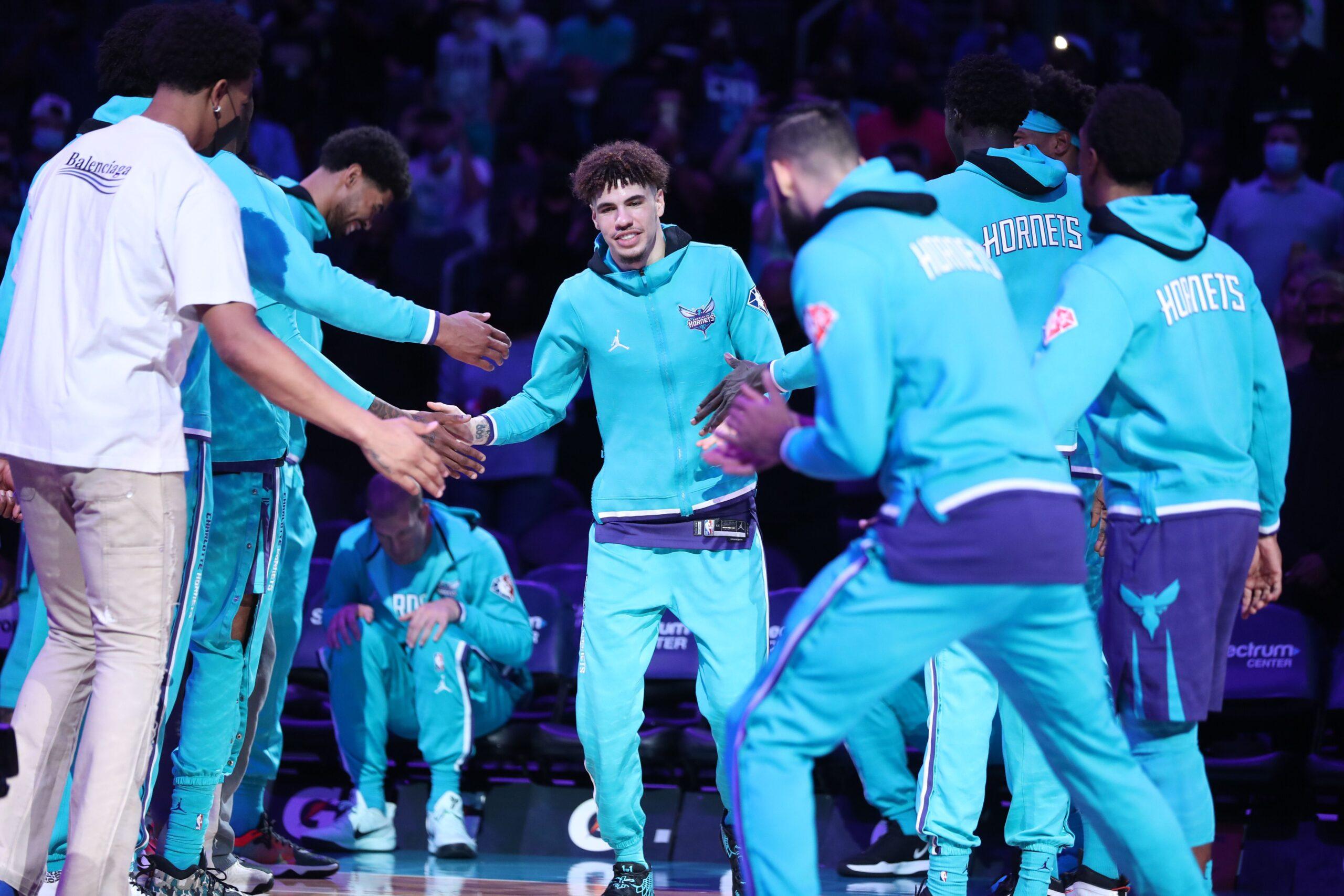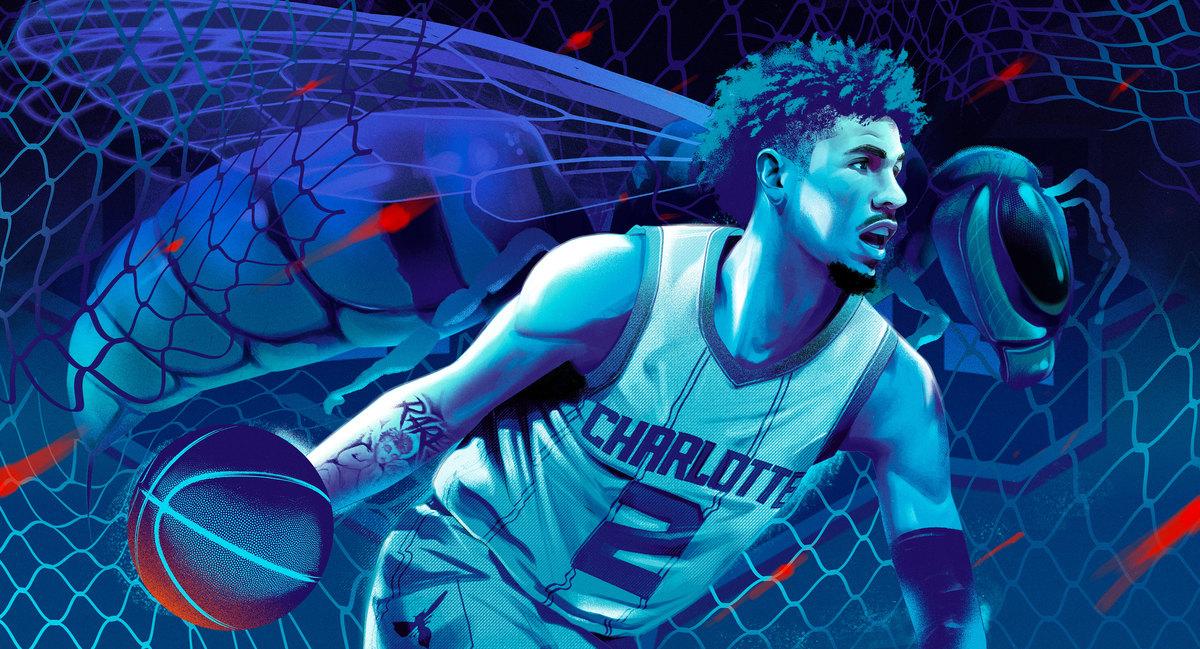Beyond Your Wildest Dreams
It took one season for LaMelo Ball to prove his out-of-this-world potential, and to change the trajectory of the long-suffering Charlotte Hornets. Now comes the challenge—and the thrill—of building a future around the 20-year-old’s boundless imagination.Some stars blink into the universe softly. Others roll up in a Lamborghini and a custom suit and trench coat in the same neon color—chartreuse, if we’re being specific—to match. What’s the point, after all, in a blinding talent pretending to be anything else? The suit was made to match the car, but LaMelo Ball is the kind of showman where you have to ask to be sure—a player daring enough to make you wonder whether he might pick up a new Lamborghini on a whim just to accessorize with the tennis-ball three-piece he already had hanging in his closet.
All possibilities are on the table. Such is the new reality for the Charlotte Hornets, whose trajectory as a franchise swerved the day they drafted Ball no. 3 last November. Winning Rookie of the Year, as it turned out, was only the beginning; Ball was so dazzling in his debut NBA season as to reorient the entire franchise around him. “He’s fearless,” Hornets head coach James Borrego says. “And I can’t teach that to him—he just has that. His elite feel, he has that. It’s my job now to make sure that we’re surrounding him with the right pieces, the right system to be successful.”
One of Ball’s mantras—and there are many—is that he is “NOT FROM HERE,” the implication being that his talent is not of this world, that a spaceship might just show up at the Spectrum Center one night to take him back home. The reality isn’t that far off. Ball sees every fast break through passing angles that don’t really exist, detecting in them some new depth that has gone unexplored for most of basketball history. His game feels iterative of all-time greats like Stephen Curry, Pete Maravich, and Magic Johnson, but through the strange alchemy of those influences, Ball will casually try things on the court that feel completely new.
“How do I even know how to do this stuff when I ain’t never heard of it or seen it or nothin’?” Ball asks himself aloud. He stops to consider the origin of it all, his place in things. The 20-year-old concludes that it all must come from some divine provenance. “Gotta be,” he says. “I’m just blessed, for real.”
You could learn to shoot like LaMelo, unorthodox flick of a release and all, but you could never learn to see the world the way he does. Creativity comes in many forms, but for Ball it seems to simply burst from his fingertips. Mitch Kupchak, the Hornets general manager, characterizes the second-year guard as a sort of incidental showman, someone who would barely even notice that he flipped a no-look pass over his shoulder in his effort to make the best play. A similar imagination spills out of LaMelo wherever he goes. “Clothes,” he says. “Shoes. Cars.” And, on occasion, clothes and shoes to match the cars.
If Ball were only a flashy player or merely a very good one, none of this would be as notable as it is. The fact that he’s both already is what now gives the Hornets undeniable and unprecedented juice, the kind of renewable energy that could carry the franchise for years to come—provided, of course, that they can find the best way to channel a star whose game is as brilliant as it is wild. “My challenge,” Borrego says, “is how far do I let him go to test the limits and the boundaries of his feel? And how do we stay within the context of the team and what we need to be successful?” It’s the best kind of problem for an NBA team to have. Ball looks like an All-Star, and the Hornets, who are off to one of their best starts in franchise history, are making the leap. Now comes the thrill—and the uncertainty—of staring back down at the Earth from midair, working out just where they’ll land.

On a late September Sunday, more than 50 members of the Hornets’ basketball operation drove the winding avenues of Myers Park, beneath a canopy of 100-year-old oaks, to Borrego’s home for the first official team meeting of the 2021-22 season. Veteran players mingled in the backyard with coaches and staffers over plates of tacos (chicken and shrimp for those on the stricter side of the NBA diet spectrum, steak for those on the other), picking as they went at a spread of chips and salsa.
“There’s no Borrego meal,” the Hornets coach says, “without chips and salsa.”
It was there that the Hornets set their goals for the season. A top-10 defense. A lower turnover rate. “Not just to make the playoffs,” Miles Bridges says, “but to make a run in the playoffs.” And in doing so, to potentially get the Hornets out of the first round for the first time since 2002. As preseason meetings go, the message was relatively standard. But for a team that had played its last season under the constraints of a global pandemic, it was also an opportunity for the whole group to finally share a space and a meal in a way they hadn’t been able to. The day after Ball was drafted, Kupchak and Borrego took the newest Hornet out for a socially distanced dinner in Charlotte. “If you were to sum up our culture, it’s like sitting at a dinner table,” Borrego later told reporters. Yet until the restrictions of the NBA and local municipalities loosened to allow it, getting the whole team around the same dinner table proved to be a challenge.
The Hornets needed a fresh start after ending their previous season with an embarrassing blowout loss to the Pacers in the play-in game, but they also needed to establish what their team culture could be under slightly more normal circumstances. Bridges is the only player left on the roster from the season before the pandemic began. The new normal was the only one most of the Hornets have ever known in Charlotte—and the only way Ball has experienced the NBA at all. The way to build stronger bonds, as Borrego saw it, was to open his doors.
Groups of three or four players had come by the house over the summer to shoot hoops in the backyard and swim in the pool with Borrego’s kids. Ball spent a number of days there, learning another side of his coach. When the Hornets first interviewed Ball in the lead-up to the draft, according to Sports Illustrated, Borrego asked the young phenom what he valued. Family, Ball told him. In time, Borrego would invite LaMelo and his brother LiAngelo over to spend time with his. And then he invited LaMelo again for dinner. And again, just because. The Borregos, Ball says, are “welcome-hearted with a welcoming home.” Whenever he comes over, there is a standing order for cheese pizza and lemon pepper wings.
The coach and the point guard didn’t spend all that much time talking basketball. “I want to talk more about life,” Borrego says. “I want to get to know him as a person. Because at the end of the day, this all comes down to trust. Will he trust me? Will I trust him? And will his teammates trust him?”
By the time the team had gathered at Borrego’s house in September, Ball had already been working with his teammates for months. LaMelo grew up in many places, but Southern California most of all. Yet when many of his peers in the league flocked to Los Angeles (the unofficial home of the NBA offseason) over the summer, Ball stayed in Charlotte. “I got a crib out here and a gym right here,” he says. Sometimes it’s that simple. After an injury to his right wrist derailed his long-range shooting at the end of last season, Ball set out to correct it by training at a pace of more than a thousand makes a day. Bridges “dragged” Ball with him to the weight room, until LaMelo wound up ranking in the top three among Hornets in total offseason lifts at the team facility. “We’re gonna put the work in,” Bridges says, “no matter what.” And then, as the daylight poured onto the practice court from the windows facing Fifth Street, Ball set out to make up for lost time.
Due to the NBA’s modified schedule last season, Ball rushed into his rookie year without summer league and without a proper training camp. His coaching staff barely knew him. He began the season coming off the bench behind Terry Rozier and Devonte’ Graham, until an opening in the lineup made clear that he should have been starting all along. There was nothing for Ball to do but take off running—no time to learn tendencies, or build habits, or establish a pick-and-roll rapport. Everything he accomplished last season came by feel.
This summer was Ball’s opportunity to fill out the foundation beneath those instincts. Most of the Hornets’ roster either stayed in Charlotte for the offseason or came back for an extended visit, which gave a genius passer room to riff without the stakes of a playoff race. When LaMelo sails a full-court outlet over the heads of smaller guards and into the hands of Gordon Hayward, it feels like a well-worn groove:
Rozier, who has blossomed into a leader in Charlotte, hosted and organized a September trip to Miami for the team to train together. Every player showed. “I told them: This is when it starts,” says Rozier, part of two conference finalists in Boston. Some of the Hornets’ staff tagged along to help with drills and officiate scrimmages. Michael Jordan, who owns the team, made an appearance and talked enormous amounts of shit from the sideline. “I’m like yo, this dude is kinda pickin’ on me!” Kelly Oubre Jr. told The Ringer’s Wosny Lambre. Ball floated up lobs for Bridges, who made just enough eye contact to read his mind. The Hornets lifted. They ran. They cranked through agility drills. And after sweating through long days, they broke bread together.
“I think that experience, more than anything, just built some chemistry,” Hayward says. “It built some relationships. Being able to go out to eat and talk with people about not-basketball. That’s something that we weren’t necessarily able to do last year because of COVID.” Once the season began, Hornets players found a print of the group photo they had taken together down in Miami waiting for them in their lockers, with a personalized message from the coaching staff written on the back.
Charlotte is more reliant on its chemistry than most. Last season, the Hornets committed more fully to a concept-driven offense—a style that trades the structure of scripted plays for the unpredictability of players making quick reads, not unlike what you might see from teams like Utah or Miami. “If I just stopped the gym and ran a set every single play, [the team] would know where to go and we could control that,” Borrego said last season. “But there’s a ceiling on our offense then. Teams will catch up.” Instead, the Hornets rely on every player to know how they should space the floor, when they should pass the ball, and what should trigger a cut—and on LaMelo, in particular, to make sense of it all. “That’s our next level,” Borrego says. “He’s an extension of me on the floor. For us to be the best team we can possibly be, he’s gotta take ownership and lead this team.”
So much of what Borrego and Ball work on together comes back to the holy trinity of game management: time, score, situation. It feels a bit like asking a virtuoso to go home and practice his scales. Yet the biggest difference between Ball and the best point guards in the game isn’t what they’re able to do, but how they bring that ability to balance. During the playoffs, Ball studied the way Chris Paul controls the action by trying something that Paul, a League Pass junkie himself, might do: locking in to watch games in full, rather than in bits and pieces. In terms of approach, it was a bit out of character.
“I don’t think he’s the kind of guy that goes back and watches NBA games all night,” Kupchak says. “But the younger generation today, they don’t really do that. They don’t really sit in front of the TV like we do and watch a game and watch the commercials. … They watch the endings of games. They watch highlights.”
LaMelo isn’t part of the Instagram Generation just because he’s found a massive following on the platform. The dunks and stepback 3s that are often clipped off into shareable highlights are a regular part of his basketball diet. Sometimes, we are what we eat.
Ball cops to this. It’s not that he doesn’t do his homework; film study has been a part of LaMelo’s life since he was in high school, and he listens closely and asks questions whenever his coaches sit down with him in front of a laptop. He’s simply still learning to read between the clips—to see not just the play in front of him, but the cumulative effect of all the plays strung together.
I ain’t gonna lie. I don’t even be thinking. I just do it.LaMelo Ball
“If we go over a scouting report, he’ll go over the scouting report,” says Bridges, one of Ball’s closest friends on the team. “But that’s just something Melo has to get better at is just his IQ on defense, on offense. And he will, for sure. He’s gonna spend more time in the film room with Coach. Coach brings him in a lot, so he’ll get better at that.”
The simpler truth is that LaMelo is already a star in every possible sense, and would be even if he never set foot in a film room again. Borrego got his start in the NBA as an assistant in the Spurs’ video dungeon; he’s conditioned to see the game through detail. Ball’s lens on the same plays is a bit more impressionistic. When he’s out on the floor, his consciousness recedes, and a purely creative impulse takes over. “I ain’t gonna lie,” he says, “I don’t even be thinking. I just do it.”
When someone enters into a state of creative flow, their normally fast-moving brain slows down, and begins exhibiting the kind of activity associated with daydreaming. The crux of Borrego’s job is to guide that flow without breaking it. Sometimes the most damaging thing you can do to a player is snap them back to reality. One of Ball’s superpowers—and there are many—is just how unashamed he is in the pursuit of brilliance. Some stars are said to make “video game plays” because they make absurd feats look easy. LaMelo makes video game plays by attempting the kinds of passes and shots most people would feel comfortable trying only from the comfort of their living room, while tapped into a virtual world that erased all consequence. The only time Ball remembers a coach categorically telling him not to do something on the court was when he briefly played professional basketball in Lithuania in 2018. Virginijus Seskus, then the head coach of Prienai-Birstonas Vytautas, didn’t speak English. But LaMelo could understand him well enough to know that he didn’t like the sizzle on his passes, and that he especially didn’t like the pull-up jumpers from just inside half court.
“So I just played my game, and if the 3s go in, he happy,” Ball says of his former coach. “If they don’t, he mad. You just gotta deal with it, so fuck it.”
That could well be another of Ball’s mantras. Three years later and he’s still letting it fly; so far this season, only three players have made more shots from at least 26 feet out. LaMelo is shooting 41 percent on 3s overall despite one of the most audacious shot profiles in basketball.
There are times when Ball’s defense can be a similar departure from orthodoxy. Every NBA defensive scheme relies on a delicate balance of assignments and rotations, many of which LaMelo will throw to the wind if he senses an opportunity to make a play on the ball. Borrego calls this: Making stuff up. “I use another term for it,” he admits. Yet even Ball’s steals are sensational. Whenever an opponent finds themselves in one of the game’s transitional spaces—a burgeoning fast break, a mad dash for a loose ball, or even the ambiguity of a rebound as it hangs in the air—you can find LaMelo one move ahead of the action, lurking as it develops. Then, he strikes. “You can just think of the pass you would make,” Ball says, “and then vice versa it.”
The trouble with this strategy, of course, is that there may be only one living soul who would make the pass that LaMelo Ball would make. Reverse engineering from a place of limitless imagination leads to its fair share of false positives. “Some passes I think people see—nope,” Ball says. “I go for the steal and it ain’t even there.”
Watching LaMelo run those gambits felt oddly familiar to Borrego, like an echo of something he had seen while coaching under Gregg Popovich in San Antonio. “I think of Pop often, in how he handled Manu [Ginobili], and how he coached him over the years,” Borrego says. “I use that in how I coach Melo. What makes him special and competitive and a winning player, you have to let that ride. You have to let it be part of your fabric as an organization. It’s gonna drive a lot of your culture and how you play. It’s instinctive. It’s competitive. It’s, in some ways, unteachable.” Although some stricter part of him—perhaps the San Antonio part of him—wants to hold Ball accountable for gambling on big plays, Borrego can’t help but consider the duality of Manu.
First, in 2006: With the Spurs protecting a three-point lead and less than 30 seconds remaining in a hard-fought Game 7, Ginobili pulls in from the weak side and inexplicably fouls Dirk Nowitzki on a layup right at the rim—allowing him a free throw to tie the game and send it to overtime. San Antonio lost in the extra period, 119-111.
And then, in 2017: On the final possession of a pivotal Game 5, James Harden shakes Ginobili out on the perimeter, steps up to the 3-point line, and rises for what would be a game-tying jumper—only to find Ginobili’s hand planted firmly on top of the ball, blocking his shot from behind. San Antonio went up 3-2 for the series, and eliminated Houston the next game.
“He took years off of Pop’s life,” Borrego says, “but Pop would say that in those moments, he was more alive than ever. I feel the same way. I can see it right now. I can feel this relationship building and growing after every single game. I love it. I love coaching this kid.
“I feel alive.”

Wherever LaMelo went when he was growing up, the ball came with him. To school. To the store. To McDonald’s. To a friend’s house. A lanky kid made his way around town with a live dribble, crossing up unsuspecting mailboxes and freezing fire hydrants where they stood. He tagged along with his older brothers until he became the 11-year-old in the 11th-grade league. Once his family vaulted into the mainstream, LaMelo became LaMelo Ball, an honest-to-god prep basketball sensation. Before he learned to drive, he learned to sign his autograph. But before he learned to do that, his father, LaVar—who at this point needs no introduction—taught him to give up the ball and run the floor.
“The way he taught it at first was: If somebody’s ahead of you, always just get it out,” LaMelo says. “So it’s always been a passing game, for real. Never really did the thing where you just wanna stay on the ball, stay on the ball, stay on the ball.”
The older kids he played with wouldn’t allow it. At 13, LaMelo helped take Chino Hills on an undefeated run to the California state championship alongside LiAngelo (who was just drafted by Charlotte’s G League affiliate) and their oldest brother, Lonzo (now of the Chicago Bulls). By 15, LaMelo had become the sport’s preeminent lightning rod—a scrawny point guard with a shock of dyed blond hair, standing just tall enough to attract every bad-faith take and moralistic judgment about what his latest dominant performance meant for the future of basketball. There was so much pearl-clutching over the (literal) reality show the Ball family had created as to distract from the easygoing prodigy in the middle of the frame.
The LaMelo the Hornets have come to know is utterly uncontroversial. In Charlotte’s locker room, Hayward is the steady veteran. Rozier is the most outspoken presence, and Bridges an emerging voice. Ball, meanwhile, has found his lane as something of a vibes commander—a bouncy, magnetic presence who brightens every interaction. As he weaves through the tunnels of the Spectrum Center, he greets every staffer by name—just as he has at pretty much every stop. “He made everyone feel important,” Dan Grida, Ball’s teammate in Australia, told Basketball Forever before the 2020 draft. LaMelo embraces teammates he just saw at practice a half-hour ago as if he hasn’t seen them in years. He shows up to even the earliest shootarounds and team meetings with a smile. He lifts spirits. He naturally defuses tension. “He just lightens up everybody’s day,” Rozier says. Even during his brief, surreal tenure as a pro in Lithuania, he always made his teammates laugh.
There are no bad days in LaMelo’s world.
“I mean, shit,” he says. “I feel like every day you breathin’, livin’, you should just be blessed. It’s for sure other people in this world going through way more shit. They ain’t got their family. Or they’re sick. They can’t even walk, can’t run. If you can get up out of bed and just do whatever you’re supposed to do—or shit, if you can breathe—you shouldn’t be mad or anything.”
There is an infectious quality to the way Ball thinks, and, for that matter, to the way he plays. Even as he blasts out All-Star production with the Hornets, LaMelo has the ball in his hands only for about as long as provisional Sixers point guard Tyrese Maxey or Celtics backup Dennis Schröder, per NBA Advanced Stats. Consider it a feature—a mechanism that launches Charlotte forward at blistering speeds. Ball is living proof that a point guard can dominate a game without demanding control of it.
I can feel this relationship building and growing after every single game. I love it. I love coaching this kid. I feel alive.James Borrego
Ball movement is, as Bridges puts it, a “pillar” of the Hornets’ way of life. “As long as we find the best shot,” he says, “we’re not worried about who’s making the play or who’s shooting it.” LaMelo will scoop up rebounds and fire them down the court, throwing a team full of natural athletes into overdrive. It wasn’t as if Charlotte hadn’t tried to amp up its pace before. The idea just didn’t take. In the season before Ball’s arrival, the Hornets ranked dead last in offensive pace. Last season they climbed to 12th. Now they’re tied for second.
“You’ve gotta run with him,” Borrego says. “You’ve gotta stay up with him. He’s constantly in the two-minute drill. He’s constantly at the line of scrimmage, reading, putting pressure on the defense. The defense has no time to relax. You can’t substitute. You can’t get guys off the floor. He’s just constantly putting pressure on you.” One superstar player in the league said the fastest game he played last season by far came against LaMelo and the Hornets. At their most frenzied, they can make stable, veteran teams completely lose their bearings.
“I’d rather be fast than slow,” Ball says.
Even in half-court situations, Charlotte doesn’t rely on any kind of centralized playmaking; almost everyone in the rotation over the past two seasons has averaged at least two or three assists per 36 minutes, as most every Hornet can handle the ball competently enough to stretch some momentary advantage into an even larger one.
“I see other players trying to make more plays than they’ve ever tried to make,” Borrego told me in March, as LaMelo’s stardom was becoming all the more clear. “They’ve become more risk-takers in some ways. You know, I get frustrated at times because I see guys that are maybe taking too many shots, trying to make a home-run play. But I think in the end, it’s pushed our program forward as far as playing with a joy and energy and an unselfish spirit. A playmaking spirit. Trusting each other to make the right play.”
This is the LaMelo Effect. The way that Ball interacts with the game is inherently social. His instinct isn’t just to pass, but to empower. Every outlet he throws is a chance for someone else to make a play. That style has not only fostered LaMelo’s own stardom, but showcased the developmental successes throughout Charlotte’s roster as well.
Running a team in one of the NBA’s smaller markets requires something of a farm-to-table approach. In Hornets franchise history, no player added through free agency has ever made an All-Star team. (Hayward, whom Charlotte never expected it would be able to sign, has a chance to be the first.) Even some of the most accomplished and beloved figures of Charlotte teams past—Alonzo Mourning, Baron Davis, and Larry Johnson, to name a few—have gone on to play more memorably for other clubs. The Hornets have spent most of their existence operating as something of a way station franchise.
“We didn’t plan on hitting home runs in free agency,” Kupchak says. “So how else can we do it?”
These days, it’s by swinging for a measured double. With LaMelo coming into his own, Charlotte has been able to shore up its roster simply by focusing on players with a kinetic profile. Mason Plumlee is a natural rim runner and lob target. Ish Smith, Ball’s backup, is a fast break waiting to happen. Oubre—who landed with the Hornets late in free agency and, in Kupchak’s estimation, is “probably better than what his contractual arrangement is”—plays a high-energy, quick-twitch game that fits seamlessly into the offense. Even the two rookies Charlotte selected in the first round of the 2021 draft (James Bouknight and Kai Jones) ranked among the fastest and bounciest prospects available.
Yet due largely to where the Hornets play, their most reliable means of adding high-level contributors remains the same: Draft well (and under Kupchak, the Hornets have drafted quite well), cultivate talent, and be patient enough to let it grow—sometimes in unexpected ways. Charlotte brought Bridges along in phases until he erupted out from his role this season as the team’s leading scorer and one of the NBA’s top 15 thus far. “Coach gives us that freedom,” Bridges says. “It doesn’t come right away, though.” For his first two years as a Hornet, Bridges had to earn the trust of the coaching staff one right play at a time. He had to hit enough shots that he could move up a level and take even more shots. “Unless you’re pick one through five, maybe six or seven,” he says, “then you’re gonna have to wait.”
To borrow a turn of phrase: Beware the fury of a patient man. Bridges has absolutely punished opponents this season with an evolved, uncompromising game. Smaller guards switching onto him don’t stand a chance. Bigs have to somehow account for the fact that a quicker, more explosive player is now hitting stepback 3s. One could hardly draw up a more perfect running mate for Ball than the player Bridges is becoming. A small-market team winning too many games to draft another ready-made star might have to bank on the idea that Bridges has already made himself into one.
Developmentally speaking, Ball is enrolled in a more accelerated program. The Hornets have given him the keys to the offense because the only way a player with his instincts can grow is in the full crush of the job, with all that that entails. He’s maturing with every game. Teammates praised Ball when he pressed Borrego to let Smith, who had the Hornets rolling, close out a win over the Nets in his place. “Melo wouldn’t have done that last year,” Bridges told reporters afterward, “but I think his main goal for the whole year is just to win.”
Lessons from last season are starting to internalize. Professional habits are clicking into place. At some point, we all grow up from ordering Oreo McFlurrys and move on to slightly bougier milkshakes laced with Froot Loops and Crunch Berries. We put away our two-door Lamborghinis for more practical four-door, SUV Lamborghinis.
The growth that LaMelo has already shown—in less than a calendar year—is enough to raise the aspirations of the entire franchise. Members of Hornets leadership say, matter-of-factly, that the progress of their team ultimately moves through their 20-year-old point guard. And why shouldn’t it? The beauty in experiencing life in the NBA through LaMelo’s boundless imagination is that it means there is always a play to be made. There is always a way through. Don’t think. Just quiet your mind, and slip away as if drifting into a dream.


